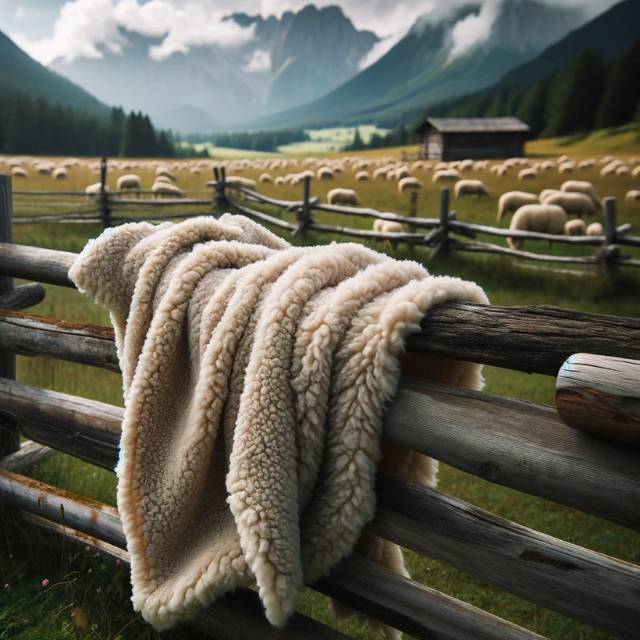Fleece is a synthetic fabric, primarily polyester, sometimes blended with natural fibers like wool or cotton.
| Feature Category | Fleece Fabric Specifications |
|---|---|
| Fiber Source | Mostly synthetic (polyester), can include recycled plastics |
| Weaving Patterns | Knit patterns, with types like polar, micro, and plush fleece |
| Dominant Colors | Wide range including pink, red, purple, grey, and more |
| Texture Spectrum | Soft, plush, varying from lightweight to heavy |
| Breathability Index | Moderate, varies with specific fleece type |
| Strength & Longevity | Durable, resistant to pilling, does not fray easily |
| Maintenance Needs | Machine washable, low maintenance, avoid high heat |
| Primary Applications | Winter apparel, blankets, sportswear, linings |
| Ecological Impact | Synthetic origin, recycled options are more eco-friendly |
| Major Exporters | Global production, no specific dominant regions |
| Comparable Fabrics | Wool (for warmth), Synthetic blends (for durability) |
Known for its light, warm, and breathable qualities, it’s a vegan alternative to wool, with a napped surface giving it a plush feel.
1. Key Takeaways
| Aspect | Details |
|---|---|
| Nature of Fleece | Synthetic fabric, mainly polyester. |
| Uses | Warm clothing, activewear. |
| Warmth & Comfort | Insulating, ideal for cold conditions. |
| Types of Fleece | Polyester, Microfleece, Polar Fleece. |
| Advantages | Insulation, softness, easy care. |
| Care Instructions | Cold/lukewarm wash, air-dry or low heat. |
| Comparison with Wool | Less warm but dries quicker, lighter. |
| Waterproof Properties | Moisture-wicking, some water-repellent. |
2. Nature of Fleece
At its core, fleece is a synthetic fabric. The primary component is polyester, renowned for its durability and quick-drying properties. When blended with natural fibers like wool or cotton, fleece gains additional attributes such as enhanced breathability and natural insulation.

Fleece, primarily made of polyester, significantly impacts the environment during its production. The process requires extensive energy and resources, contributing to ecological degradation. Research focusing on enhancing the elasticity of fleece fabric reveals that adjusting the stitch length of fleecy yarns significantly improves its elastic recovery.
Additionally, fleece is not biodegradable, meaning it can persist in the environment and contribute to pollution if not disposed of properly. However, advancements in fleece production show promise for reducing its environmental footprint.
Eco-fleece, made from recycled polyethylene terephthalate (PET), presents a more sustainable option. By repurposing used plastic, eco-fleece reduces the reliance on raw petroleum and cuts down on energy consumption. This innovation represents a step towards more environmentally friendly fabric production, though it doesn’t fully mitigate the issues of non-biodegradability and microfiber shedding
3. Uses of Fleece
The application of fleece extends beyond conventional clothing. It’s a staple in outdoor and athletic wear due to its excellent insulation. Unique items like baby ear-warmers benefit from fleece’s softness. Using Tencel and Bamboo yarns in three-thread fleece fabrics for sportswear, due to their superior moisture management and durability, enhancing comfort in athletic and medical wear.
Recognizing the environmental challenges posed by traditional fleece, many brands are now adopting recycled materials for their fleece products. This shift not only utilizes waste plastics, reducing landfill pressure, but also decreases the dependence on virgin petroleum-based resources.
However, an emerging environmental concern is the issue of microfiber pollution. Fleece, being a synthetic fabric, sheds tiny fibers – microfibers – during washing. These microfibers, too small to be caught by most wastewater treatment plants, end up in water bodies. A single wash of a fleece jacket can release hundreds of thousands of these fibers. They are not biodegradable and can accumulate in aquatic ecosystems, causing harm to marine life and entering the food chain.
4. Warmth & Comfort
Fleece’s structure, comprising layers of cut fibers, traps heat effectively, making it an ideal choice for cold weather. Its lightness is advantageous in wet conditions or during physical activities in cooler temperatures.

Thermal Efficiency Comparison
- Fleece: Known for its excellent insulation, fleece is designed to trap warm air close to the body, making it highly effective in cold conditions.
- Natural Fibers (Wool, Cotton): While natural fibers like wool are inherently warm, they may not match the lightweight insulation efficiency of fleece. Wool, in particular, provides superior warmth but can be heavier.
Breathability and Moisture-Wicking
Fleece:
- Breathability: Fleece allows for some air circulation, but its synthetic nature can limit breathability compared to natural fibers.
- Moisture-Wicking: It excels in wicking moisture away from the body, keeping the wearer dry. However, it may not dissipate moisture as effectively as some natural alternatives.
Natural Fibers:
- Breathability: Natural fibers like cotton are highly breathable, allowing for better air flow, which can be more comfortable in less cold conditions.
- Moisture-Wicking: Wool, for example, is excellent at moisture management, absorbing and releasing moisture effectively but may feel wetter in very damp conditions compared to fleece.
5. Types of Fleece
- Polyester Fleece: Offers a balance between durability and moisture-wicking, making it suitable for winter apparel and blankets.
- Microfleece: Characterized by its thin and lightweight nature, it provides excellent insulation, often used in activewear layers.
- Polar Fleece: Known for its high quality, thickness, and warmth, polar fleece is preferred for heavy-duty jackets and coats.
- French Terry Fleece: Recognizable by its looped texture, this blend is common in casual wear and activewear.
- Cotton Fleece: Valued for its softness and breathability, cotton fleece is ideal for milder climates and is often used in sweatshirts and light jackets.
6. Advantages of Fleece
Practical Advantages
| Feature | Advantage |
|---|---|
| Insulation | Superior insulation without added bulk. |
| Softness | Comfortable texture, ideal in cold weather. |
| Easy Care | Wrinkle-resistant, easy to wash and maintain. |
| Cost-Effectiveness | More affordable than natural wool. |
| Lightweight | Ideal for layering without adding weight. |
Environmental Considerations
- Challenges in Recycling: Fleece, especially non-recycled polyester, is difficult to recycle, leading to potential waste and pollution issues.
- Ecological Impact: The production and disposal of fleece contribute to environmental degradation, particularly due to its non-biodegradability and microfiber shedding during washes.
Comparison with More Sustainable Materials
| Material | Cost-Effectiveness | Lifetime of Products |
|---|---|---|
| Fleece | Lower upfront cost, higher environmental cost. | Shorter lifespan due to wear from washing. |
| Sustainable Materials | Higher initial cost, lower environmental impact. | Often more durable, longer lifespan, reducing replacement need. |
7. Caring for Fleece
- Laundry Tips: It’s vital to check care labels before washing fleece. Using a mild detergent and avoiding harsh chemicals like bleach and fabric softeners can prolong the life of fleece items. Washing fleece in cold or lukewarm water on a gentle cycle, preferably inside out, can minimize pilling.
- Drying and Storage: Fleece should be dried on a low heat setting or air-dried. Proper storage in a cool, dry place is essential to maintain the fabric’s quality.
- Comparison with Wool: Wool, while warmer and more water-repellent, is also heavier and requires more careful maintenance than fleece. Fleece, on the other hand, is lighter, dries faster, and is easier to care for, though it is less warm and breathable compared to wool.
- Waterproof Properties: Fleece itself is not inherently waterproof but has moisture-wicking capabilities. It’s often used as a layer in waterproof/breathable systems. Certain types of fleece are treated to be water-repellent, offering additional protection against light precipitation.
Research on improving pilling resistance in polyester cotton blended fleece fabrics has shown remarkable success, enhancing the fabric’s surface quality.
8. Conclusion
Fleece’s versatility, comfort, and practicality make it a favored fabric in various applications, from everyday clothing to specialized gear. Understanding its properties and care requirements can enhance the longevity and performance of fleece items, making them a valuable addition to any wardrobe.
